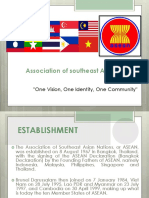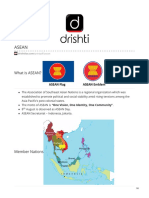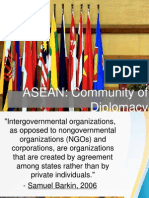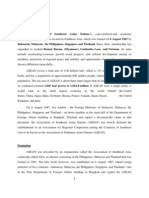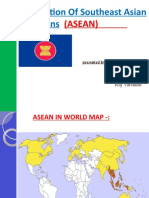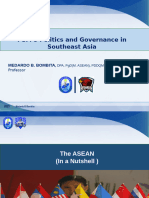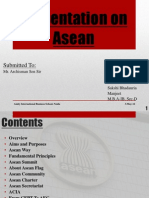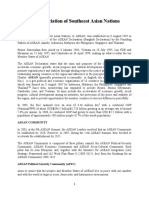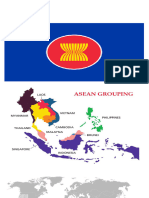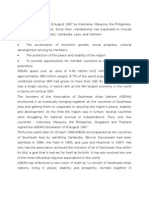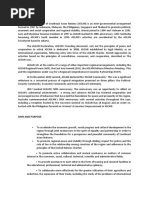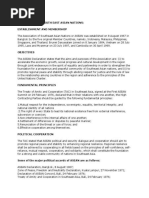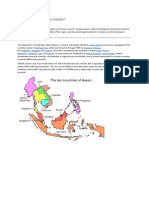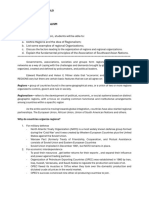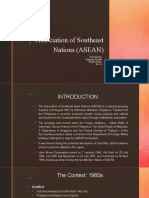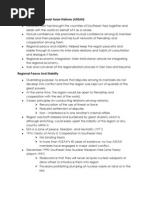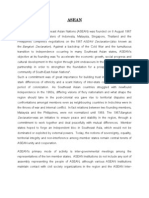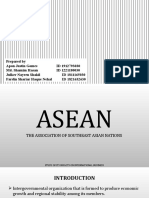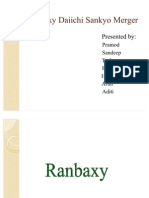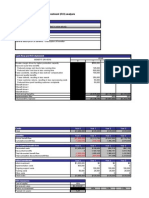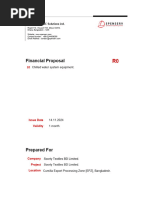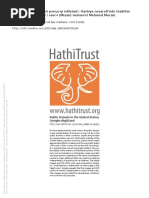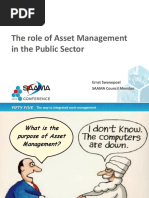0 ratings0% found this document useful (0 votes)
110 viewsAsean: (Association of Southeast Asian Nation)
Asean: (Association of Southeast Asian Nation)
Uploaded by
arunrathore_28ASEAN was established in 1967 and currently has 10 member countries. It was formed to promote economic growth, cultural development, and peace in Southeast Asia. Key goals included establishing cooperation through reducing tariffs and expanding trade. ASEAN operates through consensus-based decision making and non-interference in country affairs. Major activities include establishing free trade areas to liberalize investment and goods movement between member economies. ASEAN has expanded relations with countries like India through regional forums and trade agreements.
Copyright:
Attribution Non-Commercial (BY-NC)
Available Formats
Download as PPT, PDF, TXT or read online from Scribd
Asean: (Association of Southeast Asian Nation)
Asean: (Association of Southeast Asian Nation)
Uploaded by
arunrathore_280 ratings0% found this document useful (0 votes)
110 views19 pagesASEAN was established in 1967 and currently has 10 member countries. It was formed to promote economic growth, cultural development, and peace in Southeast Asia. Key goals included establishing cooperation through reducing tariffs and expanding trade. ASEAN operates through consensus-based decision making and non-interference in country affairs. Major activities include establishing free trade areas to liberalize investment and goods movement between member economies. ASEAN has expanded relations with countries like India through regional forums and trade agreements.
Original Title
ASEAN12
Copyright
© Attribution Non-Commercial (BY-NC)
Available Formats
PPT, PDF, TXT or read online from Scribd
Share this document
Did you find this document useful?
Is this content inappropriate?
ASEAN was established in 1967 and currently has 10 member countries. It was formed to promote economic growth, cultural development, and peace in Southeast Asia. Key goals included establishing cooperation through reducing tariffs and expanding trade. ASEAN operates through consensus-based decision making and non-interference in country affairs. Major activities include establishing free trade areas to liberalize investment and goods movement between member economies. ASEAN has expanded relations with countries like India through regional forums and trade agreements.
Copyright:
Attribution Non-Commercial (BY-NC)
Available Formats
Download as PPT, PDF, TXT or read online from Scribd
Download as ppt, pdf, or txt
0 ratings0% found this document useful (0 votes)
110 views19 pagesAsean: (Association of Southeast Asian Nation)
Asean: (Association of Southeast Asian Nation)
Uploaded by
arunrathore_28ASEAN was established in 1967 and currently has 10 member countries. It was formed to promote economic growth, cultural development, and peace in Southeast Asia. Key goals included establishing cooperation through reducing tariffs and expanding trade. ASEAN operates through consensus-based decision making and non-interference in country affairs. Major activities include establishing free trade areas to liberalize investment and goods movement between member economies. ASEAN has expanded relations with countries like India through regional forums and trade agreements.
Copyright:
Attribution Non-Commercial (BY-NC)
Available Formats
Download as PPT, PDF, TXT or read online from Scribd
Download as ppt, pdf, or txt
You are on page 1of 19
ASEAN
(ASSOCIATION OF SOUTHEAST ASIAN
NATION)
PRESENTED BY: ARUN
HISTORY OF ASEAN
ASEAN was preceded by an organisation called the
Associates of Southeast Asia, commonly called ASA, an
alliance consisting of the Philippines, Malaysia and
Thailand that was formed in 1961.
The bloc itself, however, was established on 8 August
1967, when foreign ministers of five countries– Indonesia,
Malaysia, the Philippines, Singapore, and Thailand– met at
the Thai Department of Foreign Affairs building in
Bangkok and signed the ASEAN Declaration, more
commonly known as the Bangkok Declaration.
Which are the ASEAN COUNTRIES?
ASEAN was formed on 8th Aug 1967 by foreign minister’s of 5 countries located
in Southeast Asia signed an agreement in Bangkok. The country name as follows:
•Indonesia,
•Malaysia,
•the Philippines,
•Singapore,
•Thailand,
Later joined the group as follows:
•Brunei – on 8 Jan 1984.
•Vietnam – on 28 Jul 1995.
•Laos – on 23 Jul 1997. ASEAN FLAG
•Burma (Myanmar) – on 23 Jul 1997 &
•Cambodia – on 30 Apr 1999.
Why was ASEAN formed?
ASEAN aim and purpose is to promote:
Economic growth, Social progress, Cultural Development
among its member countries;
Protection of peace & stability in the region;
To provide opportunities for member countries to discuss
differences peacefully;
To provide assistance to each other in the form of training
and research facilities in the educational, professional,
technical and administrative spheres;
To collaborate more effectively for the greater utilisation of
their agriculture and industries, the expansion of their trade.
ASEAN motto is "One Vision, One Identity, One
Community"
ASEAN ACTIVITIES
In 1990 -East Asia Economic Caucus
In 1992 -Common Effective Preferential Tariff (CEPT)
In 1997 -Chiang Mai Initiative
In 2001 -Nuclear weapon-free zone
In 2002 -Trans boundary Haze Pollution
In 2005 -The ASEAN-Wildlife Enforcement Network and the Asia-
Pacific Partnership on Clean Development and
Climate
ASEAN WAYS
mutual respect for the independence,
sovereignty,
equality,
territorial integrity, and national identity of all nations;
the right of every State to lead its national existence free from
external interference, subversion or coercion;
non-interference in the internal affairs of one another;
settlement of differences or disputes by peaceful manner;
renunciation of the threat or use of force; and
effective cooperation among themselves.
All of these features, namely non-interference, informality,
minimal institutionalisation, consultation and consensus, non-use
of force and non-confrontation have constituted what is called
the ASEAN Way.
ASEAN SUMMIT
The organisation holds meetings, known as the ASEAN Summit, where
heads of government of each member meet to discuss and resolve
regional issues, as well as to conduct other meetings with other countries
outside of the bloc with the intention of promoting external relations.
Formal Summit was first held in Bali, Indonesia in 1976.
The formal summit meets for three days. The usual itinerary is as
follows:
Leaders of member states would hold an internal organisation meeting.
Leaders of member states would hold a conference together with
foreign ministers of the ASEAN Regional Forum.
A meeting, known as ASEAN Plus Three, is set for leaders of three
Dialogue Partners (People's Republic of China, Japan, South Korea)
A separate meeting, known as ASEAN-CER, is set for another set of
leaders of two Dialogue Partners (Australia, New Zealand)
ASEAN FREE TRADE AREA (AFTA)
The foundation of the AEC is the ASEAN Free Trade Area
(AFTA), a common external preferential tariff scheme to
promote the free flow of goods within ASEAN.
An agreement by the member nations of ASEAN
concerning local manufacturing in all ASEAN countries.
Signed on 28 January 1992 in Singapore.
ASEAN initially signed by 6 countries-Brunei, Indonesia,
Malaysia, the Philippines, Singapore and Thailand.
Vietnam joined in 1995, Laos and Myanmar in 1997, and
Cambodia in 1999.
WHAT ARE THE OBJECTIVES OF
AFTA
To encourage inflow of foreign investment into this
region.
To establish free trade area in the member countries.
To reduce tariff of the products produced in ASEAN
countries.
AFTA with other countries
ASEAN has concluded free trade agreements with
China,
Canada,
European union,
United States,
Korea,
Japan,
Australia,
Russia,
Pakistan,
New Zealand and
most recently India.
Comprehensive Investment Area
The ASEAN Comprehensive Investment Area (ACIA) will
encourage the free flow of investment within ASEAN.
All industries are to be opened up for investment
National treatment is granted immediately to ASEAN investors
Elimination of investment impediments
Streamlining of investment process and procedures
Enhancing transparency
Undertaking investment facilitation measures.
INDIA – ASEAN FTA
The India-ASEAN Free Trade Agreement (FTA) was finally
signed, on 13 August 2009 at Bangkok, after six years of
negotiations.
The agreement is only for trade-in-goods and did not include
software and information technology.
The AIFTA would eliminate tariffs on about 4000 products
by the year 2013 and 2016.
Objectives of AIFta?
strengthen and enhance economic, trade and investment
co-operation between the Parties;
progressively liberalise and promote trade in goods and
services as well as create a transparent, liberal and
facilitative investment regime;
explore new areas and develop appropriate measures for
closer economic co-operation between the Parties; and
facilitate the more effective economic integration of the
new ASEAN Member States and bridge the development
gap among the Parties.
INDIA – ASEAN RELATIONS
In 1992 - India became a sectoral dialogue partner of
ASEAN.
In 1995- ASEAN invited India to become a full dialogue
partner of ASEAN.
In 1996 – India became the member of the ASEAN Regional
Forum (ARF).
Comprehensive Economic Cooperation Agreement (CECA)
eg. Mekong-Ganga-Cooperation (MGC) and the BIMST-EC
India –ASEAN CURRENT ISSUES
India is negotiating with ASEAN in order to expand the
trade on request-basis for the following:
INVESTMENT
SERVICES
The two sides aim to increase their USD 44-billion trade to
USD 50 billion by the end of 2010.
THANK YOU
You might also like
- PIMCO COF IV Marketing Deck - Israel - 03232023 - 5732Document64 pagesPIMCO COF IV Marketing Deck - Israel - 03232023 - 5732moshe2mosheNo ratings yet
- Asean PPTDocument42 pagesAsean PPTDiane Erika Lopez Modesto100% (4)
- Association of Southeast Asian NationsDocument32 pagesAssociation of Southeast Asian NationsDevkant RathNo ratings yet
- Original Eco..Document37 pagesOriginal Eco..Shweta SawantNo ratings yet
- Association of South - East Asian Nations: EstablishmentDocument10 pagesAssociation of South - East Asian Nations: EstablishmentSonia LawsonNo ratings yet
- Asean: (ASEAN) Is A Political and EconomicDocument33 pagesAsean: (ASEAN) Is A Political and EconomicNeel KeshariaNo ratings yet
- What Is ASEAN?Document6 pagesWhat Is ASEAN?AnushkaNo ratings yet
- Asean Upsc Notes 32Document6 pagesAsean Upsc Notes 32Anu PamaNo ratings yet
- Orca Share Media1569753464607Document30 pagesOrca Share Media1569753464607Seth OprecioNo ratings yet
- Diplomacy - AseanDocument37 pagesDiplomacy - AseanMiyu KawashiNo ratings yet
- Chapter-1 IntoductionDocument35 pagesChapter-1 IntoductionAman BrarNo ratings yet
- AseanDocument24 pagesAseanPratik BhotikaNo ratings yet
- Association of Southeast Asian Nations: (Asean)Document17 pagesAssociation of Southeast Asian Nations: (Asean)abcrajNo ratings yet
- ASEAN - Tiffany's ReportDocument23 pagesASEAN - Tiffany's ReportCzerina Gene Dela CruzNo ratings yet
- PSM5 0Document41 pagesPSM5 0mbbombitaNo ratings yet
- Association of Southeast Asian NationsDocument3 pagesAssociation of Southeast Asian Nations70173381No ratings yet
- Prelim-Reviewer-Asean 2Document7 pagesPrelim-Reviewer-Asean 2velarde gwynethNo ratings yet
- DOC-20241205-WA0013.Document8 pagesDOC-20241205-WA0013.Shivangi AgrawalNo ratings yet
- Presentation On Asean: Submitted To: Submitted byDocument20 pagesPresentation On Asean: Submitted To: Submitted byAnuj PateriyaNo ratings yet
- AseanDocument3 pagesAseanbryanNo ratings yet
- The Association of Southeast Asian Nations: EstablishmentDocument13 pagesThe Association of Southeast Asian Nations: EstablishmentMuzzammil IbrahimNo ratings yet
- ASEANDocument24 pagesASEANshetani151No ratings yet
- ASEAN FinalDocument46 pagesASEAN FinalDeepika AmesarNo ratings yet
- Asean Integration IntroductionDocument11 pagesAsean Integration IntroductionlovelyNo ratings yet
- Contemporary World Asian Regional Organizations 1. AseanDocument4 pagesContemporary World Asian Regional Organizations 1. AseanZarina Kate CondoyNo ratings yet
- Presentation ON Association of South-East Asian Nations (Asean)Document12 pagesPresentation ON Association of South-East Asian Nations (Asean)Tarun KumarNo ratings yet
- Regional CooperationDocument17 pagesRegional Cooperationchandasai29No ratings yet
- ASEANDocument51 pagesASEANDirty water in my faceuNo ratings yet
- Contemporary World - Association of South East Asian NationsDocument3 pagesContemporary World - Association of South East Asian NationsMicaela ContrerasNo ratings yet
- ASEANDocument11 pagesASEANShashi KapoorNo ratings yet
- AseanDocument95 pagesAseanmohsin188No ratings yet
- Asean VS BricsDocument24 pagesAsean VS BricsMumuNo ratings yet
- Asean DocumentsDocument76 pagesAsean DocumentsStephanie BiyoNo ratings yet
- ASEANDocument9 pagesASEANjoyghatak2003No ratings yet
- Asean Association of South East Asian Nations: Establishment and MembershipDocument5 pagesAsean Association of South East Asian Nations: Establishment and MembershipCss Aspirant100% (1)
- Asean NewDocument50 pagesAsean NewUmair JavedNo ratings yet
- Economic and Regional IntegrationsDocument54 pagesEconomic and Regional IntegrationsSheenam AroraNo ratings yet
- What Is The Purpose of ASEANDocument12 pagesWhat Is The Purpose of ASEANm3r0k050% (2)
- AseanDocument12 pagesAseanisha aggarwalNo ratings yet
- The ASEAN Free Trade AreaDocument3 pagesThe ASEAN Free Trade AreaWihl Mathew ZalatarNo ratings yet
- ASEANDocument4 pagesASEANNaresh GundlapalliNo ratings yet
- Association of South East Asian Nations and Asia Pacific Economic Co-OperationDocument11 pagesAssociation of South East Asian Nations and Asia Pacific Economic Co-OperationSuketu JhaveriNo ratings yet
- Association of Southeast Asian NationsDocument22 pagesAssociation of Southeast Asian NationsJhonabie Suligan CadeliñaNo ratings yet
- Asean India IrDocument21 pagesAsean India IrAbhishekNo ratings yet
- Project On AseanDocument15 pagesProject On Aseanjabdulshafiq100% (2)
- 5Document1 page5courtney.dmp25No ratings yet
- TOPIC 7 ASIAN REGIONALISM_120545Document4 pagesTOPIC 7 ASIAN REGIONALISM_120545Ashley AgustinNo ratings yet
- Association of Southeast Asian NationsDocument7 pagesAssociation of Southeast Asian NationsSanjita TanDonNo ratings yet
- Business Environment Unit 4Document42 pagesBusiness Environment Unit 4gargi4a16No ratings yet
- International Business: Submitted byDocument21 pagesInternational Business: Submitted byRoshin P.SNo ratings yet
- Association of Southeast Nations (ASEAN) : Presented By: Rukmani Khadka Roshan Sunar Sec: ADocument18 pagesAssociation of Southeast Nations (ASEAN) : Presented By: Rukmani Khadka Roshan Sunar Sec: ARukmani Khadka100% (1)
- ASEAN Integration DuronDocument1 pageASEAN Integration DuronKrizea Marie DuronNo ratings yet
- Apontamentos ASEANDocument8 pagesApontamentos ASEANTália SantosNo ratings yet
- ASEAN Integration DuronDocument1 pageASEAN Integration DuronKrizea Marie DuronNo ratings yet
- Association of Southeast Asian Nations (ASEAN)Document9 pagesAssociation of Southeast Asian Nations (ASEAN)Nazelle Ashley AstibeNo ratings yet
- Asean 2Document8 pagesAsean 2Faysal SalamatNo ratings yet
- 7e. May 2017 Folded Brochure of ASEAN Community1Document12 pages7e. May 2017 Folded Brochure of ASEAN Community1alessandro.crivellaroNo ratings yet
- Vanilla SlidesDocument15 pagesVanilla SlidesMd. Mehedi HasanNo ratings yet
- Gale Researcher Guide for: Rivalry in Asia-Pacific Regions: APEC and ASEANFrom EverandGale Researcher Guide for: Rivalry in Asia-Pacific Regions: APEC and ASEANNo ratings yet
- PepsiDocument2 pagesPepsiarunrathore_28No ratings yet
- Wal-Mart's Inventory & Logistics Management.: A Business SuccessDocument52 pagesWal-Mart's Inventory & Logistics Management.: A Business Successarunrathore_28No ratings yet
- Supply Chain Management: Industry PresentationDocument23 pagesSupply Chain Management: Industry Presentationarunrathore_28No ratings yet
- Ranbaxy Daiichi Sankyo FinalDocument42 pagesRanbaxy Daiichi Sankyo Finalarunrathore_28No ratings yet
- FA ECM Aug 2017Document5 pagesFA ECM Aug 2017neng Elmira geulisNo ratings yet
- Wipro BpoDocument17 pagesWipro BpoRidhi KanugoNo ratings yet
- ROI AnalysisDocument2 pagesROI Analysisapi-3809857100% (2)
- CBE5 Module 3Document24 pagesCBE5 Module 3s. magxNo ratings yet
- Module 2 - PRACTICING ENTREPRENEURSHIPDocument15 pagesModule 2 - PRACTICING ENTREPRENEURSHIPTrixy Fauna LuminarioNo ratings yet
- Daily Activity Report: - KSA TeamDocument2 pagesDaily Activity Report: - KSA TeamHaidar Ali ZaidiNo ratings yet
- R0 Offer Air Cooled Chiller System Soorty Textiles BD LtdDocument5 pagesR0 Offer Air Cooled Chiller System Soorty Textiles BD LtdFahadNo ratings yet
- Salient Features - RA 9184Document96 pagesSalient Features - RA 9184Dante RevamonteNo ratings yet
- Mizancı Murat Hürriyet Vadisinde Bir Pence-I İstibdatDocument107 pagesMizancı Murat Hürriyet Vadisinde Bir Pence-I İstibdatEbru AykutNo ratings yet
- Corporate GovernanceDocument28 pagesCorporate GovernanceAmrin Mim Beg100% (1)
- LRN Format - BRDocument2 pagesLRN Format - BRADR LAW FIRM CHENNAINo ratings yet
- BOGENHOLD LeerDocument19 pagesBOGENHOLD LeerEmiliano EnriqueNo ratings yet
- SAAMA The Role of Asset Management in The Public SectorDocument34 pagesSAAMA The Role of Asset Management in The Public SectorKhairahMukhlisahHertantoNo ratings yet
- Tiffany Co Brand BookDocument43 pagesTiffany Co Brand BookChen ZhengfengNo ratings yet
- A Comprehensive Study On Financial Planning and ForecastingDocument31 pagesA Comprehensive Study On Financial Planning and ForecastingInternational Journal of Innovative Science and Research TechnologyNo ratings yet
- 8D-Report 000010003683 0001 20211216 092039Document2 pages8D-Report 000010003683 0001 20211216 092039raul leijaNo ratings yet
- Module D Fundamentals of Global Energy Business Mac McClellandDocument14 pagesModule D Fundamentals of Global Energy Business Mac McClellandJamal EldebaisNo ratings yet
- Marketing Planning (Hico IceCream)Document24 pagesMarketing Planning (Hico IceCream)prosmatic92% (13)
- Why The Rich Are Getting Richer by Robert T. Kiyosaki: Download HereDocument3 pagesWhy The Rich Are Getting Richer by Robert T. Kiyosaki: Download HereAndrew MichaelNo ratings yet
- Finance ManagementDocument2 pagesFinance ManagementKirkol SaeENo ratings yet
- MSPP LeafletDocument4 pagesMSPP LeafletChayan MukherjeeNo ratings yet
- Project CourseoutlineDocument2 pagesProject CourseoutlineGetaneh SeifuNo ratings yet
- Kader - Graded Project CastrolDocument8 pagesKader - Graded Project Castrolnabeelrishan9999No ratings yet
- F R O M C A R R I E R MC# DOT Driver Truck # Trailer # Cell #Document2 pagesF R O M C A R R I E R MC# DOT Driver Truck # Trailer # Cell #Ivan PetrovicNo ratings yet
- Strategic Marketing ManagementDocument43 pagesStrategic Marketing ManagementАлександрNo ratings yet
- Paint Computation Molasses Tank: THK (Um) 200.00Document2 pagesPaint Computation Molasses Tank: THK (Um) 200.00Diosdado Mingi Jr.No ratings yet
- Essay IsmailDocument8 pagesEssay IsmailSyed Aamir AhmedNo ratings yet
- Commercialization of Sports in India.24Document24 pagesCommercialization of Sports in India.24irshadkhan870985No ratings yet
- Lesson 1 - Introduction To Service Management and ITILDocument27 pagesLesson 1 - Introduction To Service Management and ITILvenki_hinfotechNo ratings yet

